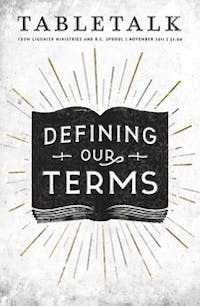
Request your free, three-month trial to Tabletalk magazine. You’ll receive the print issue monthly and gain immediate digital access to decades of archives. This trial is risk-free. No credit card required.
Try Tabletalk NowAlready receive Tabletalk magazine every month?
Verify your email address to gain unlimited access.
Anyone who is employed or has a mortgage, credit card, or car is familiar with contracts — and the “blessings” and “curses” that they impose. Not all legal agreements are the same, of course. A contract differs significantly from a last will and testament, which can make you a beneficiary of someone else’s estate. You benefit not by a “work-for-hire” arrangement or a payment program but by a gift.
Similarly, there are different kinds of covenants in the Bible. Reformed theology has discerned in Scripture three overarching covenants. The covenant of redemption is the agreement of the Father, Son, and Spirit from all eternity to elect, redeem, and call a people, with the Son as the Mediator (John 6:39–44; 10; 17:1–5, 9–11; Rom. 8:28–31). Adam was made the federal head of the human race in the covenant of works, and Jesus Christ is the federal head of His new humanity in the covenant of grace, which includes believers and their children. In Adam, we inherit guilt and corruption, leading to death, and in Christ, we inherit justification and new birth, leading to everlasting life (Rom. 5:12–21).
The background of biblical covenants is international politics. The most obvious parallel was the treaty that a great king (suzerain) would impose upon a lesser king (vassal) on the basis of having liberated him from an invading army. Obviously, the vassal was in no position to negotiate the treaty but simply accepted its terms (stipulations), as well as the suzerain’s pledge of support for obedience and threat of destruction for disobedience (sanctions).
We see this pattern clearly in the relationship God established with the human race in Adam. As God’s image-bearer and vassal, Adam was promised the right to everlasting blessing (the Tree of Life) for himself and his posterity if he fulfilled his trial and was threatened with death for treason. Just as a king is the federal head of his kingdom, Adam was the federal head of the whole human race, and when he broke this covenant, we fell with him under the curse of guilt, corruption, and death.
However, from Genesis 3:15 on, God’s surprising announcement of the gospel unfolds in history until He fulfills His promise in the person and work of Jesus Christ. Our “last Adam,” Jesus fulfills the trial and wins for His posterity the right to eat from the Tree of Life. With His evangelical promise in Genesis 3:15, God established a covenant of grace no longer on the basis of law but of promise, and He established a church that “began to call upon the name of the LORD” (Gen. 4:26).
Unlike the original covenant with Adam, in the covenant with Abraham in Genesis 15, God makes all the promises and, in a surprising vision, passes through pieces of several animals. As part of the secular treaties, the great king made the vassal pass through the pieces, accepting the stipulations and sanctions, but here God assumes full responsibility. The same unilateral promise is evident in the covenant that God makes with David: although he and his heirs will be unfaithful, God will never fail to keep a Davidic heir on the throne until the heir greater than David himself assumes it.
While the gracious covenant continues, at Sinai God also makes a covenant with Israel as a nation. Individual Israelites are still justified by grace through faith in the coming Messiah, but the nation’s status in the land is temporal and conditional. At Sinai, God made no promises, but, as the suzerain who had liberated Israel from Egypt, He simply delivered the terms and sanctions: blessing (long life in the land) and curse (being “cut off” from the land, sent off into exile). Israel accepted the terms, saying, “‘All that the LORD has spoken we will do, and we will be obedient.’ And Moses took the blood and threw it on the people and said, ‘Behold the blood of the covenant that the LORD has made with you in accordance with all these words’” (Ex. 24:7–8). The blessing or cursing of the nation depended on Israel’s faithfulness.
“But like Adam they transgressed the covenant” (Hos. 6:7). As God’s attorneys, the prophets brought God’s case against the people for violating this national covenant. Whereas God passed through the pieces to secure the Abrahamic covenant of grace, He delivered a different message and said that He would make Israel pass through the pieces and bear its temporal judgment through exile (Jer. 34:1–22). Nevertheless, on the basis of the Abrahamic covenant of grace, renewed in the new covenant, God promised a new creation and a new exodus based on the forgiveness of sin (Jer. 31:31–34).
When Jesus inaugurated the Lord’s Supper in the upper room, He declared, “This is my blood of the covenant, which is poured out for many for the forgiveness of sins.” (Matt. 26:28). Instead of a covenant of law (“Do this and you shall live”), it is a covenant of free mercy. Unlike Moses, He did not dash the blood on the people, confirming their oath, but pledged His oath in His own blood. He alone passed between the pieces, bearing the judgment in our place. It’s a gift, just like a last will and testament. In fact, this is just how the book of Hebrews contrasts the old covenant with the new (Heb. 9:15–22). Hebrews speaks of the “unchangeable oath” that rests on God’s promise rather than on human activity (Heb. 6:17–20). Paul, too, contrasts the covenant of works and the covenant of grace by appealing to the Abrahamic covenant: work-reward versus faith-gift (Rom. 4:1–5). The later (Sinaitic) covenant could not annul the earlier (Abrahamic) promise (Gal. 3:7–29; 4:21–31).
